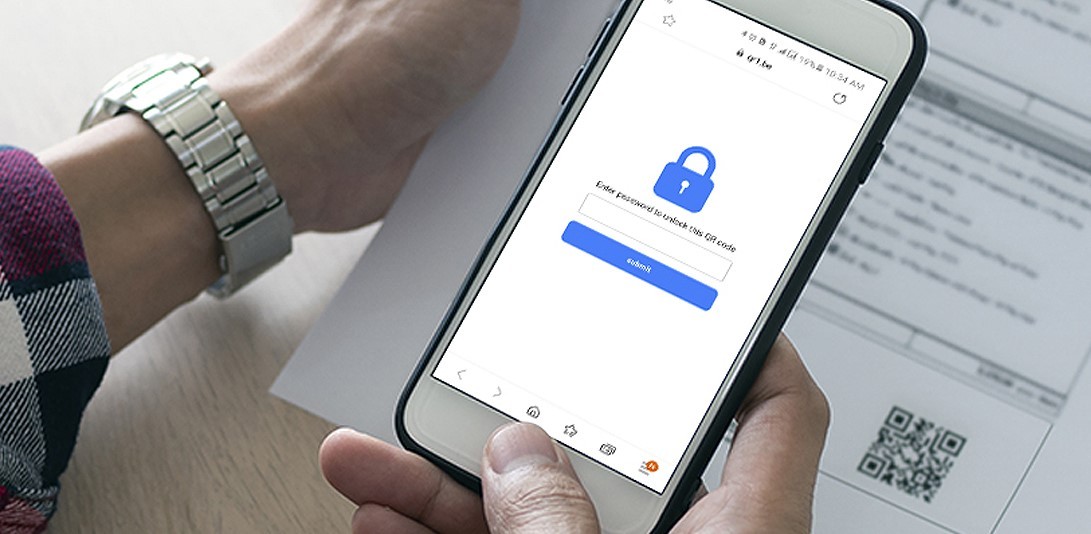We’ve seen what QR codes can do to transmit valuable information instantaneously from one end to the other. But the data acquired by QR codes readers eliminate content exclusivity for its targeted recipients.
And, with each QR codes placed in your corporation or commercial building, everyone who chances to notice will quickly obtain the information it contains by just scanning the code with their cellphones.
However, if you want to employ QR codes to share unique content with specified persons, there is a powerful technique to use QR codes that include receiver-specific information.
A novel QR codes technique is introduced to make file-sharing restrictions a reality. And that option is known as a password-protected QR codes, which allows you to safeguard your QR codes information and only allows individuals having access to open the data to read and download the report.
Table of Contents
What is a QR code with a password?
A password-protected QR code is a dynamic QR codes option that enables users to encrypt their QR code material once a scanner scans the code using password-protected software. This feature allows the QR codes owner to limit who can view and download the content by providing the intended receiver with a passcode to unlock the file or information.
This function is beneficial for individuals or brands that provide private or premium material to those in need, such as workshop and training facilities, utility billing companies, and others.
Spaces that people can use the password-protected QR code feature in it
With its initial release during the height of the QR codes information phishing and more, people and entrepreneurs that use them in their personal or business use can employ the password protection feature in their QR codes campaigns to safeguard important documents or information.
By tapping on the use of a free QR code generator with a logo that has this feature, the following marketing and business spaces can apply its usage.
- Online learning firms
- Utility Billing Systems
- Offices and corporations that exchange crucial information
How can you use a password-protected QR code to secure your content?
In a world where data has become the gilded ingot for which many firms and individuals. vie, securing crucial data is necessary for all users and brands who begin to engage in the virtual environment.
However, as the ease of data sharing is pushed, the significance of information protection lessens. And here are three simple steps you can take to encrypt your material using a passcode QR code feature.
Open and register for an account with a QR code generator to generate your QR code.
Before creating a password-protected QR codes, you must first open and sign up for an online. QR codes generator that supports content security like a password-protected QR code feature. After you’ve signed up for a QR code generator, you can start creating your QR code.
QR codes kinds that you can produce and enable the password-protection option include URL QR codes, PDF QR codes, and more. After choosing and completing the necessary procedures in your selected QR codes solution. You may generate your dynamic QR codes, adjust its QR codes layout, perform a scan test, and save it.
Navigate to the track data tab and select the QR code format you want to use to enable the feature.
Proceed to access the track data page of the QR codes creator after the QR codes has been produced, customized, and stored. Locate your QR code’s QR codes category. Because you modified the style of your QR codes, it will be simple for you to identify. QR codes you want to use to enable the function.
Turn your QR codes into a password-protected one.
Simply click on the lock symbol to convert the QR codes into a password-protected one. A pop-up window will appear, prompting you to set your password. After selecting the password, clear the disable passcode option to enable your password-protected QR codes function.
A password-protected QR code is a dynamic QR codes option that enables users to encrypt. Their QR code material once a scanner scans the code using password-protected software. This feature allows the QR codes owner to limit who can view and download the content. By providing the intended receiver with a passcode to unlock the file or information.
This function is beneficial for individuals or brands that provide private or premium material to those in need, such as workshop and training facilities, utility billing companies, and others.
Spaces that people can use the password-protected QR code feature in it
With its initial release during the height of the QR codes information phishing and more. People and entrepreneurs that use them in their personal or business use can employ the password protection. Feature in their QR codes campaigns to safeguard important documents or information.
In a world where data has become the gilded ingot for which many firms and individuals. vie, securing crucial data is necessary for all users and brands who begin to engage in the virtual environment.
However, as the ease of data sharing is pushed, the significance of information protection lessens. And here are three simple steps you can take to encrypt your material using a passcode QR code feature. It’s the likelihood of it getting into the wrong hands grows. As data privacy and security are issues that people must address, the file-sharing business is working hard to provide. The most advanced data security features for most consumers.
Conclusion:
In a society where information exchange is simple and accessible. It’s the likelihood of it getting into the wrong hands grows. As data privacy and security are issues that people must address, the file-sharing business is working hard to provide. The most advanced data security features for most consumers.
With QR codes being one of the most popular methods of communication today. Having a password-protected function is an essential feature that everybody must possess. Create a password-protected QR codes unique to your training course and business, and never worry about getting it accessed by unauthorized individuals.












